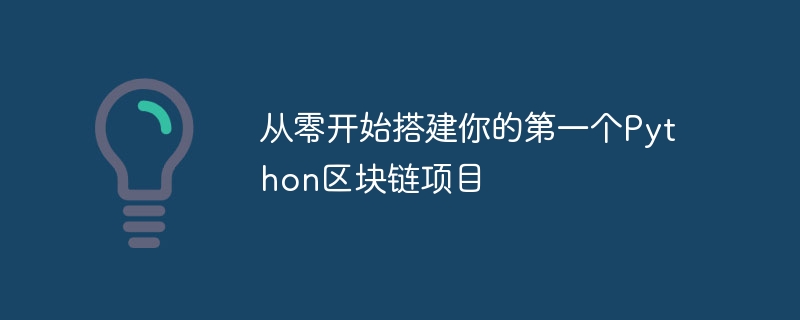從零開始建立你的第一個Python區塊鏈項目

1. 區塊鏈概述
區塊鏈是一種分散式資料庫,用於以安全、透明和防篡改的方式記錄交易。它由一個鏈狀結構組成,其中每個區塊都包含一定數量的交易資訊、前一個區塊的哈希值和其他元資料。區塊鏈的技術核心是分散式帳本和共識機制,實質上是一種去中心化的資料庫。
2. Python中的區塊鏈實作
首先,我們建立一個新的python專案,並安裝必要的程式庫。
Python import hashlib import JSON from datetime import datetime
然後,我們創建一個新的區塊鏈類別。
python
class Blockchain:
def __init__(self):
self.chain = []
self.create_genesis_block()
def create_genesis_block(self):
"""
创建创世区块
"""
genesis_block = {
"index": 0,
"timestamp": datetime.now().strftime("%Y-%m-%d %H:%M:%S"),
"data": "Genesis block",
"previous_hash": "0",
}
self.chain.append(genesis_block)
def add_block(self, data):
"""
添加新区块到区块链中
"""
new_block = {
"index": len(self.chain),
"timestamp": datetime.now().strftime("%Y-%m-%d %H:%M:%S"),
"data": data,
"previous_hash": self.chain[-1]["hash"],
}
self.chain.append(new_block)
def get_block_hash(self, block):
"""
获取区块的哈希值
"""
block_string = json.dumps(block, sort_keys=True).encode()
return hashlib.sha256(block_string).hexdigest()
def is_chain_valid(self):
"""
检查区块链是否有效
"""
for i in range(1, len(self.chain)):
current_block = self.chain[i]
previous_block = self.chain[i - 1]
if current_block["previous_hash"] != self.get_block_hash(previous_block):
return False
if self.get_block_hash(current_block) != current_block["hash"]:
return False
return True3. 運行區塊鏈
現在,我們可以運行我們的區塊鏈了。
python
blockchain = Blockchain()
blockchain.add_block("Hello, world!")
blockchain.add_block("This is a test.")
print(blockchain.chain)輸出結果如下:
[
{
"index": 0,
"timestamp": "2023-03-08 15:46:17",
"data": "Genesis block",
"previous_hash": "0",
},
{
"index": 1,
"timestamp": "2023-03-08 15:46:18",
"data": "Hello, world!",
"previous_hash": "e3b0c44298fc1c149afbf4c8996fb92427ae41e4649b934ca495991b7852b855",
},
{
"index": 2,
"timestamp": "2023-03-08 15:46:19",
"data": "This is a test.",
"previous_hash": "0a753b9f3c2650581980d3D1d1b47f56d63e6c27b813b7ec4461863b4c724a2f",
}
]4. 結論
#透過本文,你已經了解了區塊鏈的基本概念,並學會如何使用Python實現一個簡單的區塊鏈。你可以將此作為基礎,進一步探索區塊鏈的應用和開發。
以上是從零開始建立你的第一個Python區塊鏈項目的詳細內容。更多資訊請關注PHP中文網其他相關文章!

熱AI工具

Undresser.AI Undress
人工智慧驅動的應用程序,用於創建逼真的裸體照片

AI Clothes Remover
用於從照片中去除衣服的線上人工智慧工具。

Undress AI Tool
免費脫衣圖片

Clothoff.io
AI脫衣器

Video Face Swap
使用我們完全免費的人工智慧換臉工具,輕鬆在任何影片中換臉!

熱門文章

熱工具

記事本++7.3.1
好用且免費的程式碼編輯器

SublimeText3漢化版
中文版,非常好用

禪工作室 13.0.1
強大的PHP整合開發環境

Dreamweaver CS6
視覺化網頁開發工具

SublimeText3 Mac版
神級程式碼編輯軟體(SublimeText3)
 Python開發_python的安裝
May 07, 2025 pm 04:33 PM
Python開發_python的安裝
May 07, 2025 pm 04:33 PM
Python可以在多種平台上運行,包括我們常見的:Windows、Unix、Linux和Macintosh。本文將詳細介紹在Windows操作系統中安裝Python的過程。我的操作系統是Windows7,32位版本。在安裝Python時,我們可以選擇從源碼安裝,也可以選擇已經編譯好的二進製版本進行安裝。我這裡選擇的是後者。步驟一下載安裝包我們從Python的官方網站:http://www.python.org下載Python的安裝包。我選擇的版本是:python-3.3.2.msi點擊下載後,我
 2025最安全交易所TOP5:黑U避坑指南,資金100%保命法則
May 08, 2025 pm 08:27 PM
2025最安全交易所TOP5:黑U避坑指南,資金100%保命法則
May 08, 2025 pm 08:27 PM
在加密貨幣交易領域,交易所的安全性始終是用戶關注的重點。 2025年,經過多年的發展和演變,一些交易所憑藉其卓越的安全措施和用戶體驗脫穎而出。本文將詳細介紹2025年最安全的五大交易所,並提供如何避開黑U(黑客攻擊用戶)的實用指南,確保您的資金100%安全。
 歐意OKX6.118.0版本最新下載教程
May 07, 2025 pm 06:51 PM
歐意OKX6.118.0版本最新下載教程
May 07, 2025 pm 06:51 PM
歐意OKX6.118.0版本最新下載教程:1、點擊文章中快捷鏈接;2、點擊下載即可(如果是網頁用戶請先進行信息註冊)。最新安卓版本v6.118.0優化了部分功能和體驗,讓交易更容易。立即更新App,感受更加極致的交易體驗。
 2025年十大數字虛擬幣交易APP排行 十大數字幣交易所app匯總
May 08, 2025 pm 05:24 PM
2025年十大數字虛擬幣交易APP排行 十大數字幣交易所app匯總
May 08, 2025 pm 05:24 PM
2025年十大數字虛擬幣交易APP排行:1. Binance:全球領先,提供高效交易和多種金融產品。 2. OKX:創新多樣,支持多種交易類型。 3. Huobi:穩定可靠,服務優質。 4. Coinbase:新手友好,界面簡潔。 5. Kraken:專業交易者首選,工具強大。 6. Bitfinex:高效交易,交易對豐富。 7. Bittrex:安全合規,監管合作。
 ok交易所國內如何註冊? ok交易平台大陸新手註冊使用指南
May 08, 2025 pm 10:51 PM
ok交易所國內如何註冊? ok交易平台大陸新手註冊使用指南
May 08, 2025 pm 10:51 PM
在加密貨幣市場中,選擇一個可靠的交易平台是至關重要的。 OK交易平台作為全球知名的數字資產交易所,吸引了大量大陸新手用戶。本指南將詳細介紹如何在OK交易平台上進行註冊和使用,幫助新手用戶快速上手。
 .NET Core快速入門教程 1、開篇:說說.NET Core的那些事兒
May 07, 2025 pm 04:54 PM
.NET Core快速入門教程 1、開篇:說說.NET Core的那些事兒
May 07, 2025 pm 04:54 PM
一、.NETCore的起源談到.NETCore,就不能不提它的前身.NET。當年Java風頭正盛,微軟也對Java青睞有加,Windows平台上的Java虛擬機就是微軟依據JVM標准開發的,據稱是當時性能最佳的Java虛擬機。然而,微軟有自己的小算盤,試圖將Java與Windows平台捆綁,增加一些Windows特有的功能。 Sun公司對此不滿,導致雙方關係破裂,微軟隨後推出了.NET。 .NET從誕生之初就借鑒了Java的許多特性,並在語言特性和窗體開發等方面逐漸超越了Java。 Java在1.6版
 歐意OKX5.1最新版本下載
May 07, 2025 pm 06:48 PM
歐意OKX5.1最新版本下載
May 07, 2025 pm 06:48 PM
歐意OKX6.118.0版本最新下載教程:1、點擊文章中快捷鏈接;2、點擊下載即可(如果是網頁用戶請先進行信息註冊)。最新安卓版本v6.118.0優化了部分功能和體驗,讓交易更容易。立即更新App,感受更加極致的交易體驗。
 期貨交易平台TOP10:永續合約與期權交易
May 08, 2025 pm 07:12 PM
期貨交易平台TOP10:永續合約與期權交易
May 08, 2025 pm 07:12 PM
在加密貨幣市場中,期貨交易平台扮演著重要角色,尤其是在永續合約和期權交易方面。以下是當前市場上備受推崇的十大期貨交易平台,並詳細介紹它們在永續合約和期權交易方面的特點和優勢。






